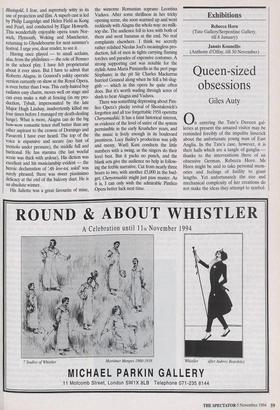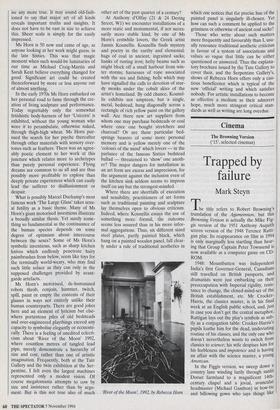Exhibitions
Rebecca Horn (Tate Gallery/Serpentine Gallery, till 8 January) Jannis Kounellis (Anthony d'Offay, till 30 November)
Queen-sized obsessions
Giles Auty
On entering the Tate's Duveen gal- leries at present the amazed visitor may be reminded forcibly of the impolite limerick about the unfortunate young man of East Anglia. In the Tate's case, however, it is their halls which are a tangle of ganglia thanks to the interventions there of an obsessive German, Rebecca Horn. Ms Horn might be said to take personal mem- ories and feelings of futility to giant lengths. Yet unfortunately the size and mechanical complexity of her creations do not make the ideas they attempt to symbol- ise any more true. It may sound old-fash- ioned to say that major art of all kinds reveals important truths and insights. It does not have to be vast in size to achieve this. Sheer scale is simply for the easily impressed.
Ms Horn is 50 now and came of age, as anyone looking at her work might guess, in the late Sixties. This was that magic moment when such would-be luminaries of our time as Michael Craig-Martin and Sarah Kent believe everything changed for good. Significant art could be created thenceforward by more or less anyone out of almost anything.
In the early 1970s Ms Horn embarked on her personal road to fame through the cre- ation of living sculpture and performance. Today regrettably only the somewhat fetishistic body-harness of her 'Unicorn' is exhibited, without the young woman who wore it to perambulate, otherwise naked, through thigh-high wheat. Ms Horn pur- sued the search for her psyche thereafter through other materials with sensory over- tones such as feathers. There was an agree- ably poetic element to her work at this juncture which relates more to archetypes than purely personal experience. Flying dreams are common to us all and are thus possibly more profitable to explore than deeply private experiences which can easily lead the sufferer to disillusionment or despair.
What is possibly Marcel Duchamp's most famous work 'The Large Glass' takes sexu- al futility as a basic theme. Many of Ms Horn's giant motorised inventions illustrate a broadly similar thesis. Yet surely some- thing so fundamental as the continuance of the human species depends on some degree of optimism about intercourse between the sexes? Some of Ms Horn's symbolic inventions, such as sharp kitchen knives which endlessly penetrate hairy paintbrushes from below, seem like toys for the terminally world-weary, who may find such little solace as they can only in the supposed challenges provided by avant- garde artefacts.
Ms Horn's motorised, de-humanised robots throb, conjoin, hammer, twitch, spill, paint or empty the contents of their glasses in ways not entirely unlike their human counterparts. There are good jokes here and an element of lyricism but else- where portentous piles of old bedsteads and over-engineered playthings exceed any capacity to symbolise elegantly or economi- cally. There is a feeling of unedited eclecti- cism about 'River of the Moon' 1992, where countless metres of tangled lead pipe, merely demonstrate a hierarchy of size and cost, rather than one of artistic imagination. Frequently, both at the Tate Gallery and the twin exhibition at the Ser- pentine, I felt even the largest machines represented only a modest vision. Of course megalomania attempts to cow by size and insistence rather than by argu- ment. But is this not true also of much other art of the past quarter of a century?
At Anthony d'Offay (21 & 24 Dering Street, W1) we encounter installations of a more static and monumental, if not neces- sarily more stable kind, by one of Ms Horn's erstwhile lovers, the Greek artist Jannis Kounellis. Kounellis finds mystery and poetry in the earthy and elemental: bags of coal in ancient, ingrained sacks; hanks of rusting iron; hefty beams such as might block off a small harbour from win- ter storms; harnesses of rope associated with the sea and fishing; bells which may have signalled the calls to devotion of stur- dy monks under the cobalt skies of the artist's homeland. By odd chance, Kounel- lis exhibits not umpteen, but a single, metal, bedstead, hung diagonally across a rectangle of rich yellow paint on the gallery wall. Are there new art suppliers from whom one may purchase bedsteads or coal where once one bought stretchers and charcoal? Or are these particular bed- springs bearers of some more personal memory and is yellow merely one of the `colours of the mind' which lovers — in the parlance of the famous Sixties bedstead ballad — threatened to 'show' one anoth- er? The major dangers for installation as an art form are excess and imprecision, for the argument against the inclusion even of the kitchen sink seldom seems to impress itself on any but the strongest-minded.
Where there are shortfalls of execution and sensibility, practitioners of art forms such as traditional painting and sculpture lay themselves open to obvious criticism. Indeed, where Kounellis essays the use of something more formal, the outcome seems less assured than in his more infor- mal aggregations. Thus, six different sized steel plates, partly painted black, which hang on a painted wooden panel, fall clear- ly under a rule of traditional aesthetics in `River of the Moon, 1992, by Rebecca Horn which one notices that the precise hue of the painted panel is singularly ill-chosen. Yet how can such a comment be applied to the griminess or otherwise of ancient coal sacks?
Those who write about such matters more frequently and favourably than I, usu- ally renounce traditional aesthetic criticism in favour of a system of associations and values so vague that little can be either questioned or answered. Thus the explana- tory brochure issued by the Tate Gallery to cover their, and the Serpentine Gallery's, shows of Rebecca Horn offers only a cau- tious beneficence which is typical of the new 'official' writing and which satisfies nobody. For artistic installations to become as effective a medium as their admirers hope, much more stringent critical stan- dards as well as writing are long overdue.











































































 Previous page
Previous page